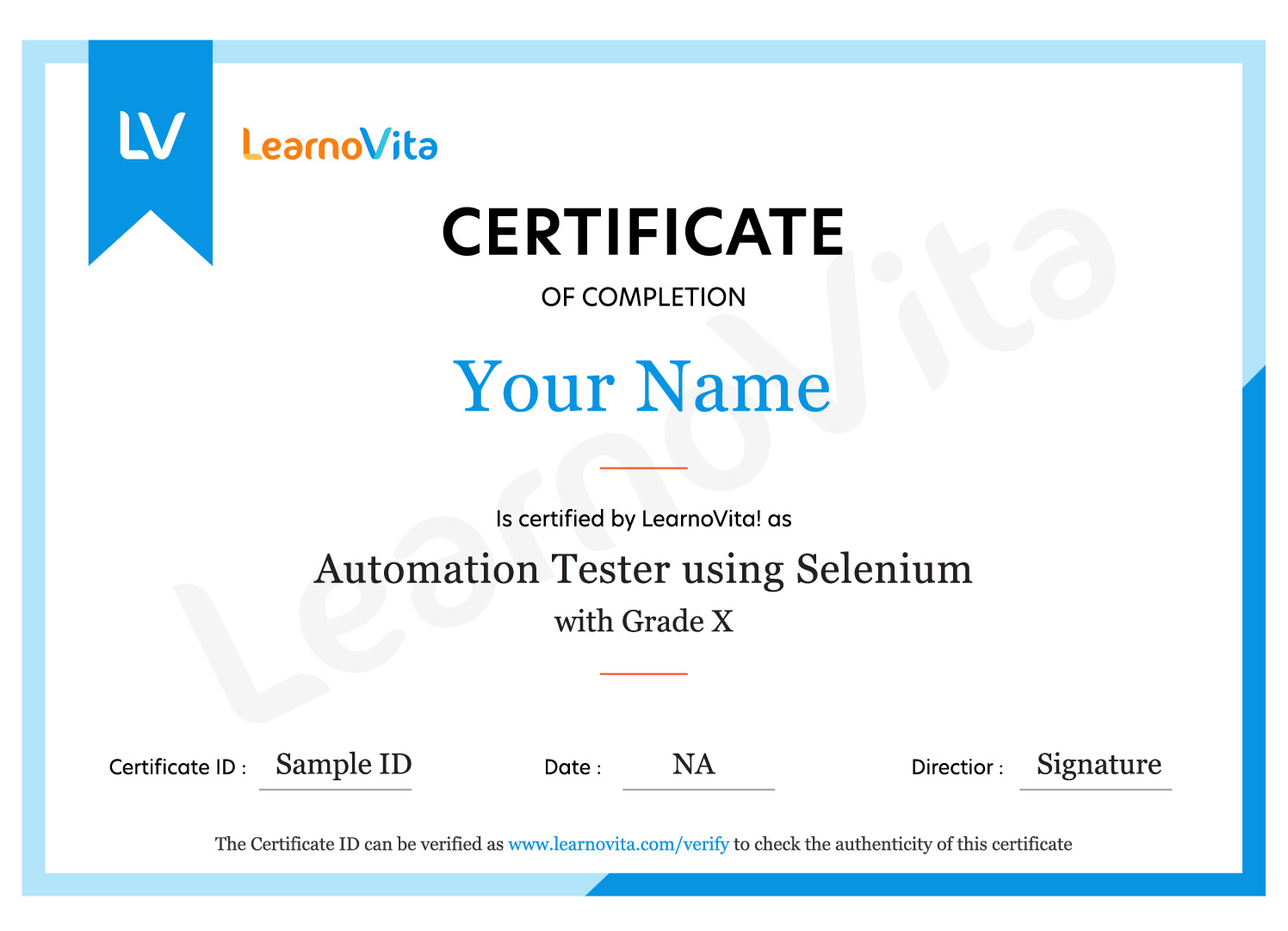A Complete Overview of R Programming Course
Our R Programming Online Course offers an in-depth, hands-on approach to mastering R, one of the most widely used languages for data analysis and statistical computing. The R Programming Online Training is designed to equip you with the skill necessary to handle real-world data, create meaningful visualizations, and build statistical model. From data manipulation advanced machine learning technique, this course covers it all. By the end you will be prepared to earn your R Programming Certification Course, validating your expertise the field. This certification will enhance credibility and make valuable asset in the data science and analytics domain. Additionally we provide robust R Programming Placement support connecting you with top companies seeking skilled professionals. Whether you're a beginner looking to advance your career, this course provide the tool and opportunities to succeed the competitive world of data science.
Additional Info
Exploring Future Trends in R Programming Course
- Integration with Machine Learning:
R programming is increasingly being used for machine learning applications. With its comprehensive libraries like caret and randomForest R offers an efficient environment for model building validation and tuning. As AI and machine learning evolve R’s role in predictive analytics and automation will continue to expand. The trend of integrating machine learning algorithms with R ensures that data professionals stay competitive in the job market. R's ability to handle a variety of machine learning models will keep it at the forefront of data science advancements.
- Big Data Analytics:
As the volume of data grows R programming’s capability to handle large datasets with packages like dplyr and data table becomes crucial. With the integration of tools like Hadoop and Spark, R is increasingly used in big data analytic. It will continue to play significant role analyzing data at scale, enabling professionals to draw insights from massive datasets efficiently and cost-effectively R’s scalability in big data environments will make it indispensable large-scale data analytics projects.
- Advanced Data Visualization:
R is already renowned for its data visualization capabilities, and trends point toward more advanced interactive visualization. Libraries like ggplot2, plotly and shiny enable users to create dynamic, web-based dashboard. The future will see a push towards real-time visualization, making it easier for decision-maker to interpret complex data enhancing business intelligence and data-driven strategie The increased demand for interactive and customizable visualizations will make R a leading tool in business analytics.
- Cloud Computing Integration:
R is moving into cloud environments, such as AWS, Microsoft Azure and Google Cloud, allowing for scalable data analysis and computation. This trend will continue as businesses shift towards cloud-based infrastructure for more cost-effective efficient data processing. The ability to run R-based analytics directly in the cloud provides flexibility and enhances collaboration making it a pivotal part of modern data science workflows. Cloud-based R applications will increasingly support collaborative and real-time data analytics across distributed team.
- R in Finance and Economics:
R is becoming a preferred tool for financial analysts and economists due to its powerful statistical capabilities. It allow for the creation of complex financial models and economic forecasts. As the financial industry seeks more predictive analytics, R's applications in risk management, algorithmic trading and economic trend analysis will only grow, leading to an increased demand for professionals skilled in R programming. R's versatility in handling time-series data will make it particularly valuable in finance and economics.
- Enhanced Statistical Analysis:
With its roots in statistics, R continues to be the go-to language for statistical analysis especially in research and academia. As statistical techniques evolve R’s library of statistical functions and models will continue to expand. Professionals will increasingly use R to solve complex problems across industrie driving deeper insights data and improving decision-making process R’s role in statistical computing will remain integral particularly in industries rely heavily on data-driven research.
- Data Science Automation:
Automating data analysis processes one of growing trends in R programming. Tools like R Markdown, Shiny, and RStudio are enhancing workflow automation enabling data scientists to streamline repetitive tasks. The future will likely see R being used more for creating end-to-end automated analytics pipelines, minimizing manual interventions and optimizing productivity in data-driven industrie. Automation will allow data professional to focus on more strategic task while increasing the efficiency of their analysis.
- Integration with Other Programming Languages:
R's integration with other programming languages like Python, Java and C++ is on the rise The interoperability between R and Python, for example, opens up broader possibilities for data scientists to use the strengths of both languages This trend of blending programming languages will enable professionals to leverage R’s data manipulation and statistical prowess alongside Python’s machine learning capabilities, fostering better solution The seamless integration of these languages will make R an even more powerful tool for interdisciplinary data science projects.
- Expanding Use in Healthcare:
In the healthcare industry, R programming is becoming increasingly relevant for predictive modeling drug development and patient outcome analysis Its robust statistical features make it a great tool for analyzing medical datasets, including genomics and epidemiological data. As healthcare continues to leverage big data and AI for patient care and research R will play a critical role in the future of healthcare analytics. R's capabilities in genomic data analysis will be a major driver of innovation in personalized medicine.
- Community-driven Package Development:
The R community is one of the most active in the open-source world, with constant contributions to new packages and librarie As data science grow, R’s ecosystem of specialized packages will continue to expand, making it a more powerful tool. The future of R programming will involve even more community-driven innovations allowing professionals to solve specific, niche problems across industries with highly specialized tools and functions. The collaborative nature of the R community will ensure that new tools and resources continue to emerge to meet evolving industry need.
Exploring Advanced Tools and Techniques in the R Programming Course
- RStudio:
RStudio is the most widely used integrated development environment (IDE) for R programming It offers a user-friendly interface making easier to write and execute R code RStudio supports features like syntax highlighting debugging tools and integrated version control. Additionally it has powerful visualization capabilities that aid exploratory data analysis Its popularity in both academia and industry makes it an essential tool for anyone learning or using R.
- ggplot2:
ggplot2 is a robust data visualization library R that enables users to create complex, multi-layered plots. Built on the Grammar of Graphics, it provides a consistent, highly customizable way to generate static, interactive, and dynamic visualizations. ggplot2 simplifies creating data plots by allowing users to map variables directly to visual properties like color, shape and size It is one of the most important tools in R for producing publication-ready graphics and performing exploratory data analysis.
- dplyr:
dplyr is an essential R package used for data manipulation and transformation It offers a range of functions for filtering, selecting, grouping, and summarizing data, which makes data cleaning and preparation fast and efficient. dplyr is part of the "tidyverse" collection of packages and operates on data frames and tibbles simplifying complex data operation.
- tidyr:
tidyr is a package in R designed to help clean and restructure data into a more manageable form It offers a range of function to tidy up messy datasets, making it easier to analyze and visualize data. The functions in tidyr simplify tasks like reshaping data pivoting tables and separating combined column tidyr works seamlessly with other "tidyverse" packages like dplyr ensuring that data manipulation tasks are streamlined and efficient in R programming workflow.
- Shiny:
Shiny is powerful framework in R for building interactive web applications. With Shiny users can create dashboards, interactive plots and data-driven reports that update real time based on user input. It integrates smoothly with other R packages like ggplot2 and dplyr, making it ideal for building dynamic data applications. Shiny is widely used for creating business intelligence tools, data visualizations and interactive data analyses enabling users to communicate insights more effectively.
- caret:
caret (short for Classification and Regression Training) machine learning package in R that provides a unified interface for building predictive models. It supports a wide range of algorithms from decision trees to support vector machines and offers tools for preprocessing, feature selection and model evaluation caret simplifies the model training process by streamlining the workflows, reducing the complexity of applying machine learning techniques to datasets. It's an essential tool for anyone looking to perform machine learning in R.
- RMarkdown:
RMarkdown is an open-source authoring framework that combines R code and documentation a single document. It allows users to integrate code chunks with narrative text making it easier to produce dynamic reports, presentation and web content RMarkdown supports a wide range output format including HTML PDF and Word integrates seamlessly with RStudio This makes it an indispensable tool for creating reproducible reports and sharing analysis results in a clear and structured format.
- plotly:
plotly is an R library that enables users to create interactive plots and dashboards. It support a wide range of visualization including scatter plots, line charts, and heat maps that can be customized and embedded in web application. plotly integrates seamlessly with ggplot2 enhancing its interactivity feature This tool is especially useful for sharing interactive visualizations with non-technical stakeholders as it allows them to explore the data in real time.
- Rcpp:
Rcpp is a package that enables users to integrate C++ code within R. It enhances the performance of R applications by allowing computationally intensive tasks to be written in C++ while keeping the ease of use of R By using Rcpp data scientists and programmers can speed up their R code and handle large datasets more efficiently. Rcpp is especially useful in scenarios that require intensive numerical computation, such as large-scale simulations and statistical modeling.
- TensorFlow for R
TensorFlow for R allows users to build and train machine learning models using the TensorFlow framework directly from R This package makes it easier to use powerful deep learning tools and neural networks in R which were previously more accessible to Python developer. TensorFlow for R provides functions to build, evaluate and optimize models making it an essential tool for data scientists working in advanced field like natural language processing, computer vision, and AI-driven analytic.
Key Roles and Responsibilities in R Programming Course
- Data Scientist:
As a data scientist specializing in R, your primary responsibility to analyze and interpret complex dataset. You will leverage R's powerful statistical and machine learning capabilities to build model that help solve business problem Collaborating with other departments, you'll ensure that data-driven insights align with organizational goal You must be proficient in data wrangling visualization and predictive modeling Continuou learning of new technique and tool in R essential for staying ahead in this dynamic field.
- Data Analyst:
In this role, you will use R to collect clean and analyze data provide actionable insight. You'll be expected to produce reports and visualizations to communicate findings to non-technical stakeholders. The ability to automate data processes and improve efficiency using R packages like dplyr and ggplot2 is crucial You will often collaborate with business analysts to ensure data aligns with key business objective. Attention to detail and the ability to work with large datasets are key aspects of the role.
- Statistical Analyst:
As a statistical analyst, you will utilize R to conduct statistical analysis and hypothesis testing Your job will involve applying various statistical methods to interpret data and present the findings in an understandable format Ensuring the integrity of data analysis through proper validation technique Using R’s built-in functions for regression, time-series analysis and hypothesis testing you'll support decision-making across various sector.
- Machine Learning Engineer:
A machine learning engineer using R is responsible for developing and deploying machine learning model for range of application. You'll apply algorithms like regression clustering and classification to large datasets ensuring models are both accurate and efficient. Using R caret and other machine learning librarie you'll optimize models and improve prediction accuracy.
- R Developer:
As an R developer, you will write, debug and maintain R code for various data analysis project. Your primary responsibility will be developing custom functions and packages to meet the needs of your team or clients. You will ensure that R-based applications are optimized and scalable for large dataset Collaboration with analysts, data scientists, and other developers is necessary to create robust, efficient code. Your work will contribute to automating processes and improving the data analysis workflow.
- Business Intelligence Analyst:
Business intelligence analysts utilizing R are responsible for analyzing business data and transforming it into actionable insights. You will design and develop dashboards and reports using R packages like Shiny and ggplot2 to present finding. Working with business team you will use R identify key performance indicators and track business trend. Your role involves leveraging R's data processing capabilities to make complex data accessible to decision-maker Regularly updating and optimizing reports to reflect the most recent data is a key part of this role.
- Research Scientist:
Research scientists in fields like economic healthcare or social sciences use R to analyze experimental data and draw conclusions. You will be responsible for setting up and analyzing data experiments applying statistical methods and interpreting complex data. R’s advanced analytical capabilities such as time-series analysis and multivariate regression will be used to test hypotheses and present result Writing reports and research papers to share findings with the broader scientific community a crucial aspect of your role. Collaboration with other researcher may also be required for larger projects.
- Data Engineer:
Data engineer using R play vital role in building and maintaining infrastructure required data processing. You will work on extracting, transforming, and loading (ETL) data into systems where R can analyze it. You will be responsible for ensuring that data pipelines are efficient and reliable using R to clean and preprocess large dataset The role often involves automating the process of data extraction from multiple sources Knowledge of cloud-based data systems and integration with other data processing tool is also beneficial.
- Data Visualization Specialist:
As a data visualization specialist you will R create compelling visual representations of complex data. Your main task will be to design charts, graphs, and dashboards that make easier for stakeholders to understand trends and pattern. R’s ggplot2 and plotly packages are essential tools in your role to create both static and interactive visualization. You will work closely with analyst and other team members to ensure that visualizations meet the needs the business. A strong sense of design and storytelling important to convey data-driven insights effectively.
- Consultant in Data Science:
In this role you will act as an advisor to organizations seeking to improve their data-driven decision-making processe Using R you will help clients analyze their data, develop predictive models and interpret the result You will be expected to customize R solution to meet the specific need of each client Your role includes explaining complex statistical concepts in an easy-to-understand way for non-technical stakeholder The ability stay up-to-date with the latest R trends and technologies key to providing effective solution.
Leading Companies Looking for R Programming Experts
- Google:
Google, a global leader in technology, heavily utilizes R programming data analysis machine learning and AI applications. Data scientists at Google use R to analyze large datasets build predictive models, and refine machine learning algorithm. The company values R's statistical capabilities, especially in data mining and algorithm development. Google offers opportunitie for R professionals various roles including data scientist and machine learning engineer Their cutting-edge data-driven solutions require advanced skills in R to optimize their vast amounts of data.
- Microsoft:
Microsoft employs R programming across several of its data science and machine learning teams, particularly in Azure cloud computing and business intelligence. Microsoft integrates R with its Power BI tool for data visualization and analytics. The company focuses on using R to enhance its artificial intelligence products, developing machine learning models, and improving data analysis pipelines R professionals at Microsoft work on big data projects and innovative AI solution. They also contribute to the development of open-source R packages and tools for broader industry use.
- IBM:
IBM uses R extensively in its data analytic and artificial intelligence solution. R professional at IBM help build and deploy machine learning models that power analytics platforms and AI-driven applications. The company also uses R for predictive analytic, helping businesses make data-driven decisions across industrie. IBM’s cloud computing services, such as IBM Watson, often leverage R for deep data analysis and statistical modeling The demand for R programming skills is growing at IBM as they expand their AI and machine learning capabilities.
- Facebook (Meta):
At Meta, R is used for analyzing user behavior and building data-driven strategies. R professionals at Facebook use the language for everything from statistical analysis to building complex models that support social media algorithms. Facebook values R's ability to process and analyze large-scale data sets quickly and efficiently The company integrates R with big data platforms and machine learning tools to deliver personalized experiences to millions of user R programming expertise is crucial for teams working on analytics, user engagement and ad targeting at Meta.
- Amazon:
Amazon employs R for a variety of purposes, including supply chain optimization, product recommendation system, and customer behavior analysis. Amazon Web Services (AWS) integrates R into its cloud solutions, allowing businesses to leverage the power of R for big data analytics and machine learning Data scientists at Amazon use R to analyze large volume of transactional and operational data to predict trends and improve decision-making R programming also play a role in improving the efficiency of Amazon logistic and warehouse management system Professional skilled in R contribute to Amazon cutting-edge analytics tools and innovations.
- Deloitte:
Deloitte, a global consulting firm, utilizes R for advanced analytics, financial modeling and business intelligence Data scientist and analysts at Deloitte use R to conduct in-depth data analysis provide insights into business operations and develop custom predictive models for client. R professionals at Deloitte work on client project require customized data-driven solution The firm is also involved in developing R-based tools and models for clients in various sectors.
- Accenture:
Accenture integrates R programming into its data science and analytics services, particularly for enterprise client. The company uses R for tasks like machine learning model development data visualization and predictive analytics. R’s integration with big data platforms such as Hadoop and Spark is essential in handling large datasets for Accenture’s global client base. The company offers R professionals opportunities to work on innovative AI project, helping organizations drive digital transformation Accenture's commitment to big data and advanced analytics positions R as a key tool for their data science teams.
- SAS:
SAS is one of the leading companies in data analytics and business intelligence, and it heavily utilizes R for statistical analysis and data visualization. Professional at SAS often work with R to develop custom analytics solutions, providing insights for clients in finance, healthcare, and other industrie. R is integrated into many of SAS’s tools, such as SAS Viya, which provides data scientists and analysts with a robust environment for modeling and analysis. R professionals at SAS also contribute to the development of new R packages and functions for enhanced analytic The company offers a dynamic environment for R professionals to advance their careers in data analytic.
- Citi:
Citi uses R programming to analyze vast amounts of financial data, optimize risk management strategies, and develop predictive models for investment and trading. Data scientists at Citi rely on R for tasks like building financial models analyzing market trend, and assessing financial risk The company's extensive use of R in its operations ensures the bank stays ahead of market fluctuations and client need. Citi also uses R to power its fraud detection algorithms and enhance its customer analytic. Professional skilled in R programming can work on innovative project that shape the future of banking and finance.
- Uber:
Uber relies on R for a range of data science functions including demand forecasting, driver allocation and customer behavior analysis. The company uses R’s machine learning and statistical modeling capabilities to optimize its ride-sharing platform. R programming is also utilized for A/B testing and performance analysis which helps Uber improve its customer experience. Data scientists at Uber use R to analyze large-scale datasets to predict demand in real time and optimize route algorithm. R professionals at Uber play a key role in enhancing operational efficiency and user satisfaction within the company.



















 Regular 1:1 Mentorship From Industry Experts
Regular 1:1 Mentorship From Industry Experts




